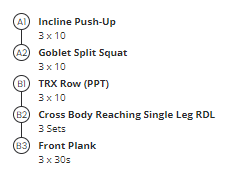Post 5 – Putting It All Together – Designing Your Workout
The first key for athletes in their strength training is to understand the types of exercises to even do. We covered that in the previous posts:
Beginner Strength Exercises – Part 1
Beginner Strength Exercises – Part 2
Effective and Efficient Strength Training Workout Plan Template for Basketball Players
The next most common question young athletes have is how to put those exercises together into a workout. The truth is there are several different approaches that have been proven to be effective at producing results. That said, the one I’ll show here is the one we prefer at PPT not just because it has been effective at producing results, but also because it’s efficient. Let’s face it, serious hoopers have a LOT of work to put in each day: Putting up Shots, Training their skills, practice or pick-up/scrimmages, conditioning, etc. While they NEED strength training they can’t spend hours in the weight room. Their strength training sessions need to be efficient to allow them to get quality work in but to get in and out of the weight room with reasonable time to leave them enough time in the day to recover and to put in other work on the court.
 Supersets
Supersets
The key to building these effective AND efficient workouts is to leverage supersets. Not the type of supersets that pair exercises that work the same muscle in order to increase the volume of stress. We’re talking about supersets for efficiency – to help the athlete get more work done in a session, in less time by reducing overall “dead” time by resting one body part while the other is working.
This is a great format for your workouts that is efficient and effective.
For an athlete, a general workout would like like this:
A1: Main Upper Body Lift
A2: Main Lower Body Lift
B1: Other Upper Body Lift
B2: Other Lower Body Lift
B3: Core Exercise
In this case A1 and A2 are performed as part of a superset, while B1, B2, and B3 are another superset. Let’s say the sets x reps was prescribed as 3 sets x 10 reps. The athlete would do 10 reps of exercise A1, followed by 10 reps of exercise A2. That’s one set. The athlete would rest, and then repeat the superset for set 2, etc. When the athlete completes all 3 sets of the exercises in superset A, they would rest, set up for all the exercises of superset B and then perform that superset in similar fashion.
To give you more specific examples, for a beginner athlete training in a 2 days/week program, using the exercise categories we described in previous articles, your Day 1 and Day 2 workouts would look like this:
Day 1 Workout
A1: Upper Body – Push – Horizontal: Push-Up
A2: Lower Body – Squat (Knee Dominant) – Unilateral: Goblet Split Squat
B1: Upper Body – Pull – Horizontal: TRX Row
B2: Lower Body – Hinge (Hip Dominant) – Bilateral: Glute Bridge Raise OR Kettlebell RDL
B3: Core – Anti-extension: Front Plank
Day 2 Workout
A1: Upper Body – Pull – Vertical: Half-Kneeling Bottoms Up KB Press
A2: Lower Body – Squat (Knee Dominant) – Bilateral: Goblet Squat to Box
B1: Upper Body – Push – Vertical: Tall-Kneeling X-Pull-Down
B2: Lower Body – Hinge (Hip Dominant) – Unilateral – Single Leg Glute Bridge Variations OR Cross-Body Reaching Single Leg RDL
B3: Core – Anti-Lateral-Flexion OR Anti-Rotation: Lateral Plank
This leverages some other concepts for proper training and efficient workouts such as:
- Balancing your body by ensuring you balance push with pull and knee dominant with hip dominant exercises.
- Making sure you are doing unilateral lower body exercises, not just bilateral
- Splitting up unilateral exercises between workouts so that you aren’t doing 5 unilateral exercises, which would double the length of your workout
There’s obviously more details – you need to include a proper warmup, you need to also train speed, power / vertical jump, and conditioning. But this will get you started on the strength training component which you aren’t getting AT ALL from your on-court work!
Use the above template, start training, train smart and start seeing the strength gains and then you can start inserting the other components of a complete training program!
